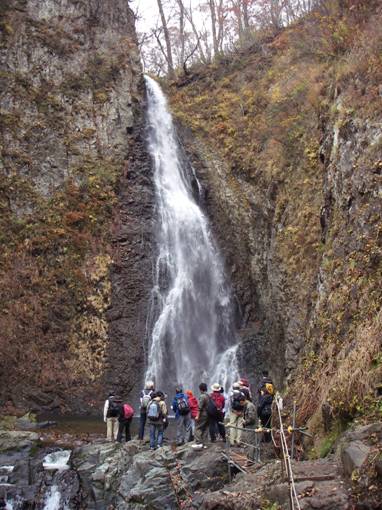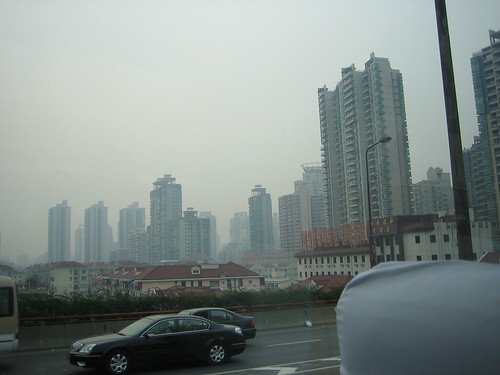In no particular order, the three things are:
- Cherry blossoms in the spring
- Color-coordinated 3G phones
- Funny old people
(Photo was taken last spring by the Imperial Palace in Tokyo. Unfortunately, I will probably miss the sakura this year.)
If you want to get a glimpse of the Weimar Republic, one way to do it is by visiting Tokyo and walking along the Sumida River. There, you can see two famous bridges inspired by German bridges that didn’t manage to outlive the Third Reich.
Eitaibashi (“Long Reign Bridge”) is one of the most famous bridges in Tokyo, and rightfully so. It crosses the Sumida River close to what would naturally be Tokyo Bay, were it not for Odaiba and all the other little islands built up there over the last few decades.
Back in the days of old Edo, Eitaibashi was a sharply arched wooden bridge, as captured in this classic woodblock print by Toyoharu Utagawa. This first bridge was built in 1698 to commemorate the 50th birthday of the fifth Tokugawa shogun, Tokugawa Tsunayoshi. It was a Big Deal at the time, because the only other way to cross the river was by ferry.
The Tokugawas planned to dismantle the bridge in 1719, but the locals on the east side (the opposite side from central Edo) were so adamant on keeping the bridge that they agreed to take over the bridge themselves. This proved to be a bad idea, because the bridge collapsed in 1807 under the weight of travellers trying to get to the Tomioka Hachimangu shrine on the east side. 1,500 people died.
Although the later Tokugawas discussed building a second Eitaibashi, the Meiji Restoration put a hold on their plans, and the new bridge was not built until 1897. It was the first iron bridge in Japan, although much of it was made of wood. This also proved to be a bad idea, because the Tokyo earthquake of 1923 tore the wood apart and ruined the second bridge.
So the third and final Eitaibashi, constructed almost immediately after the earthquake, was built entirely of iron. It was modeled after the Bridge at Remagen on the Rhine River in Germany. This wasn’t a bad idea per se, although the Bridge at Remagen was itself ill-fated: the Germans blew it up to stop Allied troops from crossing into central Germany, inspiring a Hollywood production in the process.
Anyway, the third Eitaibashi is (perhaps miraculously) still intact. Its sky-blue paint job makes it not particularly picturesque during the day, but its lighting at night is downright gorgeous. The lights turn off around midnight, much like the Tokyo Tower’s.
Kiyosubashi (“Pure Cay Bridge,” named after the adjoining districts of Kiyosumi and Nakasu), just up the river from Eitaibashi, is equally famous, although it’s more picturesque during the day thanks to its lovely blue paint job. It was also built right after the Tokyo earthquake of 1923, although it had no predecessor in that location since “central Tokyo” was not quite as big in those days.
The inspiration for Kiyosubashi was the old Mülheim Bridge in Cologne, not far from the Bridge at Remagen. Ironically, the Mülheim Bridge was also blown up, just days before the Remagen Bridge. This was only partially intentional. The Germans had set up explosive charges on the Mülheim so they could blow it up if the Allies began to cross. Then, before the Allied troops were even close to the bridge, a bomb went off near the bridge. The strengh of this bomb wasn’t enough to damage the bridge, but it was enough to set off the charges on the bridge, thus causing the Germans to suffer the ignominy of accidentally destroying their own bridge. A more modern, utilitarian Mülheim Bridge was built after the war and completed in 1951.
Sure, the shiny gold buildings, freaky demon statues, and annoying Korean tourists at Wat Phra Kaew, the royal temple of Bangkok, were plenty fun, but what really did it for me were the fantastic murals that cover the entire inner wall. What exactly is going on, or what saga it is based on, I have no idea, but I do know that I want Peter Jackson to make a movie version of it, starting tomorrow.
Update: From the Wikipedia article in The Ramayana.
Thailand’s popular national epic Ramakien is derived from the Hindu epic. In Ramakien, Sita is the daughter of Ravana and Mandodari (T’os’akanth (=Dasakand) and Mont’o). Vibhisana (P’ip’ek), the astrologer brother of Ravana, predicts calamity from the horoscope of Sita. So Ravana has her thrown into the waters, who, later, is picked by Janaka (Janok). While the main story is identical to that of the Ramayana, many other aspects were transposed into a Thai context, such as the clothes, weapons, topography, and elements of nature, which are described as being Thai in style. It has an expanded role for Hanuman and he is portrayed as a lascivious character. Ramakien can be seen in an elaborate illustration at the Wat Phra Kaew temple in Bangkok.
You can read an English translation of the Ramakien online here.
These images cannot be appreciated in such a small space, so please click on them for a larger file.
Japan’s Ministry of Environment employs about 60 “active rangers.” These assistants to the ministry’s Rangers for Nature Preservation are employed to patrol, give tours of, survey, and in general help maintain Japan’s national park system. Apparently, they also spend a lot of their time blogging:
Climbing Meakandake (active volcano in Hokkaido)
The ranger-bloggers for the Kanto region update more frequently:
A “song-house” in the Southern Japan Alps National Park.
And here are the folks in the Tohoku region:

Hikers hailing from the Tokyo metro area contemplate a waterfall during an apple-picking tour in the Shirakami mountain area.
There are also blogs for the Chubu, Shikoku, and Kinki regions. Even if you don’t read Japanese, you can scroll around the site to see some interesting nature shots courtesy of the Japanese government.
On the same day I photographed all the great old houses, I ate curry noodles for lunch:
In case you’re wondering how they taste, think curry-flavored cup noodles except 1000 times more delicious.
That left me too full to try this more…challenging delicacy:
Thankfully, it was closed for the end of Ramadan so I didn’t have to feel bad.
I came back last night from a weekend office trip to Shanghai, my first visit to China. Curzon, who has far more China experience than I do, gave me some words of warning before I left for Narita Airport: “Just remember, you’re visiting the nicest part of China, and it’s still the world’s biggest shithole.”
Shithole? Yes. Nice? Certainly. It’s a huge cow pie with flowers growing out of it. I always figured that China and Japan would have a lot in common, but it’s almost impossible to see: I returned from Shanghai with the impression that I had just been to Mirror Universe Japan, where the only commonalities are superficial, and deep down everything is exactly the opposite.
Come to mention it, they don’t even look that much alike.

A representative image: smog and gazillions of tall buildings.
I was browsing photography discussion forums, as I do once in a while, and stumbled across this fantastic little story, which I also had somehow never heard before.
I carry my Leica camera a bit more proudly these days.
The reason? A story I had never heard before – a tale of courage, integrity and humility that is only now coming to light, some 70 years after the fact.
The Leica is the pioneer 35mm camera. From a nitpicking point of view, it wasn’t the very first still camera to use 35mm movie film, but it was the first to be widely publicized and successfully marketed.
It created the “candid camera” boom of the 1930s.
It is a German product – precise, minimalist, utterly efficient. Behind its worldwide acceptance as a creative tool was a family-owned, socially oriented firm that, during the Nazi era, acted with uncommon grace, generosity and modesty.
E. Leitz Inc., designer and manufacturer of Germany’s most famous photographic product, saved its Jews.
And Ernst Leitz II, the steely eyed Protestant patriarch who headed the closely held firm as the Holocaust loomed across Europe, acted in such a way as to earn the title, “the photography industry’s Schindler.”
Continue reading Leica Freedom Train
Some are for movies, some are for music. All cry out for the Fashion SWAT treatment!
Continue reading Bollywood posters taken in Little India, George Town, Penang